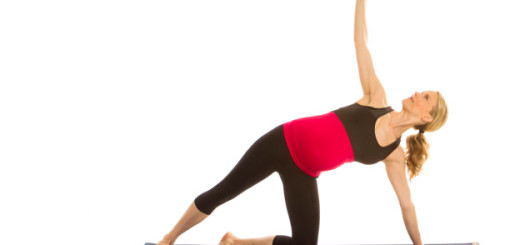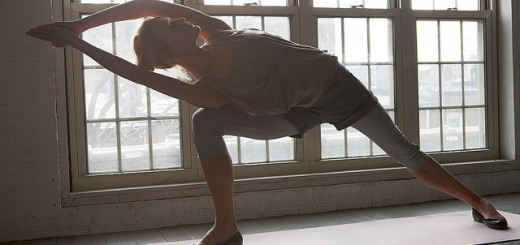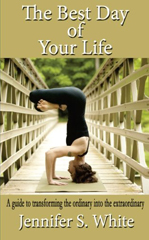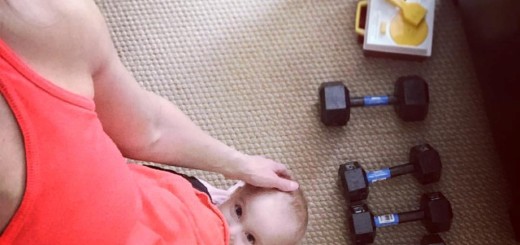5 Tips for Tackling Scary Yoga Poses.

I’ve broken my nose twice—don’t worry, neither time was yoga related (although I do have a funny story from my honeymoon).
I recently told you who I think a yogi is—and a love for recreating hip-looking Instagram photos of asanas has nothing to do with it.
Still, there’s a reason that we want to try challenging postures.
For one, if you’re someone with perpetual monkey mind (an official condition, mind you), then practicing hard-working postures on your mat can help bring you back into your body.
For another, they’re fun.
But what if they’re not?
What if you’re scared, but physically able?
Well, then I’d say consider yourself an average bear—many people are mentally intimated by postures that their bodies could likely access.
Yet, even though you’re feeling frightened, a tiny voice inside of you can’t be quieted. It’s telling you to try. This small, possibly wise, piece of you knows that you can do much more than you’re giving yourself credit for.
In honor of yogis everywhere who really want to rock out, but are afraid to even get on the starting block, here are a few mindful tips.
1. Set up your foundation. If you’d like to, say, try a headstand, then make sure you’re accessing the correct muscles for the pose. In other words, get in touch with the reality that much of headstand’s power comes from your strong core—engagement through your shoulder girdle and engaged transverse abdominals, for example. Another possible area of weakness in regards to headstand is your legs—I swear, the second someone goes upside down, she often forgets she has legs connected to her body.
Learn where you need to strengthen, as well as where you need tostop unnecessarily gripping (like the jaw and upper traps, at the base of your neck) and work asanas that don’t intimidate to help build confidence.
Are noodle legs a weakness once inverted? Then try focusing on reaching your leg long and strong in a familiar pose like three-legged dog.
2. Let go of the final pose. First, let go completely of what you think the pose should look like. Forcing ourselves into a photograph, while not connecting with the sensations in our bodies, leads to injury. Secondly, here’s my main tip: don’t even attempt the final posture. Let me explain, and let’s stick with using headstand for simplicity’s sake.
If you’d really love to try a headstand then make sure, in addition to working with a qualified teacher, that you completely forget about trying the headstand at all.
Instead, experiment with what it feels like to set up your arms (whether in traditional or tripod) and extend through your legs as you would in downward-facing dog. If this feels pretty good (and there’s no dumping through the shoulders) then maybe play with reaching one leg long, a la three-legged dog.
If, however, you’ve found that your core is the less than stellar spot, try staying in headstand prep and hugging your knees into your chest (if in tripod, rest your knees in your triceps, much like that frog thing we did back in elementary school gym class).
In short, stop thinking that yoga postures are all or nothing—they’re not. Even yogis that are comfortable in the full pose that intimates you the most almost definitely have days when they, too, are modifying.
3. Listen to your body. Okay, so you’re ready to try the pose that scares you. What’s your body saying? Our bodies will let us know when we shouldn’t go any farther. Going deeper just for the sake of a mythical end result might not be smart. On the other hand, if you’re able to reach out for more sensation and yet you’re backing away mentally—not letting your body fully engage—then you’re possibly doing yourself a huge disservice.
Personally, I stand by the “better safe than sorry” motto, but I also believe that most of us are far more capable than we think.
Keep playing your edge, pushing it just a little bit more each time, and you might discover that you have more in you than you ever thought possible—and how empowering is it to take that feeling with you when you step off of your mat?
4. And listen to your brain too. We have intellects for a reason. If you’re scared, then consider listening to that. Sure, overcoming self-imposed limitations is honestly the biggest reason that I even give certain postures a shot, but there’s also a point where we have to be authentic.
If you’re scared, that’s okay. Honor that. Don’t nurture it and feed it and always give into, but honor it.
Maybe that means your dream yoga pose won’t happen today—the good news is that there’s tomorrow.
5. Carry your successes, rather than your failures, with you off of your mat. I generally don’t beat myself up on my mat. If a pose isn’t accessible to me, then I really don’t care. Why? Because that’s not why I come to my mat in the first place.
I hop on my mat and work through my asanas to keep my body healthy, alive and supple, so that I’m a better person to work through life’s crappola during the rest of my day. That image might not be as pretty as someone who simply adores the workout and accessing all these insanely cool pretzel poses, but it’s the truth, it’s my truth at least.
If you tend to be someone who rags on yourself on your mat, then my bet is that you’re also doing this out there in the real world.
For one day, offer yourself the opportunity to notice what your body can accomplish on your yoga mat; what you rock out easily and sincerely—and then take that feeling of success out with you into the rest of your day.
If we’re capable on our mats, what are we capable of off of it? This curiosity and excitement to live to our fullest potential—that’s the mentality we want to foster.
If you’re driven to work through a pose that scares you, then congratulations—you’re willing to look adversity in the face and stick up your middle finger.
If, on the other hand, you find yourself consistently obsessed with mastering a pose, and then quickly moving on to the next one, I’m wondering what you’re chasing—or what you’re running away from.
If we’re not enjoying the poses between poses (what I like to call life), then what’s the point?
A pose is just a pose, and destinations are often not what they’re cracked up to be—and I don’t know about you, but most of the time I end up enjoying the unexpected detours a lot more anyways.
“Master your instrument, master the music, and then forget all that… and just play.” ~Charlie Parker
Photo: Author’s own.
This article was first published by elephant journal.










This is beautiful 🙂 Thank you!
Great beat ! I wish to apprentice whilst you amend your website, how can i subscribe for a weblog web site?
The account helped me a appropriate deal. I have been a little bit
familiar of this your broadcast offered bright clear concept